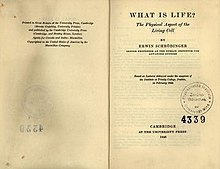What Is Life?

Title pages of 1948 edition
|
|
| Author | Erwin Schrödinger |
|---|---|
| Country | United Kingdom (Uk) |
| Language | English |
| Genre | Popular science |
| Publisher | Cambridge University Press |
|
Publication date
|
1944 |
| Media type | |
| Pages | 194 pp. |
| ISBN | |
| OCLC | 24503223 |
| 574/.01 20 | |
| LC Class | QH331 .S357 1992 |
What Is Life? The Physical Aspect of the Living Cell is a 1944 science book written for the lay reader by physicist Erwin Schrödinger. The book was based on a course of public lectures delivered by Schrödinger in February 1943, under the auspices of the Dublin Institute for Advanced Studies at Trinity College, Dublin. The lectures attracted an audience of about 400, who were warned "that the subject-matter was a difficult one and that the lectures could not be termed popular, even though the physicist’s most dreaded weapon, mathematical deduction, would hardly be utilized." Schrödinger's lecture focused on one important question: "how can the events in space and time which take place within the spatial boundary of a living organism be accounted for by physics and chemistry?"
In the book, Schrödinger introduced the idea of an "aperiodic crystal" that contained genetic information in its configuration of covalent chemical bonds. In the 1950s, this idea stimulated enthusiasm for discovering the genetic molecule. Although the existence of DNA had been known since 1869, its role in reproduction and its helical shape were still unknown at the time of Schrödinger's lecture. In retrospect, Schrödinger's aperiodic crystal can be viewed as a well-reasoned theoretical prediction of what biologists should have been looking for during their search for genetic material. Both James D. Watson, and independently, Francis Crick, co-discoverers of the structure of DNA, credited Schrödinger's book with presenting an early theoretical description of how the storage of genetic information would work, and each respectively acknowledged the book as a source of inspiration for their initial researches.
The book is based on lectures delivered under the auspices of the Institute at Trinity College, Dublin, in February 1943 and published in 1944. At that time DNA was not yet accepted as the carrier of hereditary information, which only was the case after the Hershey–Chase experiment of 1952. One of the most successful branches of physics at this time was statistical physics, and quantum mechanics, a theory which is also very statistical in its nature. Schrödinger himself is one of the founding fathers of quantum mechanics.
...
Wikipedia
